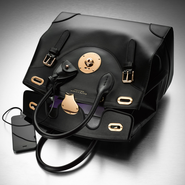- About
- Subscribe Now
- New York,
August 3, 2015

 Ralph Lauren's Ricky Bag with Light
Ralph Lauren's Ricky Bag with Light
As the wearable market grows and technology improves, consumers will increasingly look for more stylish and fashion-forward design in wearable products, according to a report by Fashionbi.
“Wearable Technology: How Fashion, Luxury and Activewear Brands Monetize Innovations” suggests that autonomous wearables that do not require an additional device such as a smartphone will become more common as technology improves. Luxury consumers are likely to select wearable devices that are autonomous, well crafted and visually pleasing, as they prefer products that combine fashion and function.
“Wearable tech is the future," said Ambika Zutshi, CEO of Fashionbi, Milan. "Fashion is fine, but imagine if the product is also smart, meaning multi-functional, giving you more than just a sense of aesthetics.
"If your beautiful watch or handbag can act as a portable charger or a fitness tracker too, imagine how much more an appeal it will add to the product. From a brand's perspective, it is a big opportunity to widen the target market, luring both the fashion and tech enthusiasts who have previously been a saturated base.
"Plus, it's a proven fact that a tech-enthusiast is ready to spend big bucks on new technology that is to satisfy his needs. Add fashion to it, and the value doubles."
What to wear
The current wearable market is dominated by passive wearable electronics that are designed to collect data and send it to a different device such as a smartphone or computer. The passive wearable cannot be used without the additional device.
Autonomous wearables, on the other hand, can be used on their own without the aid of an additional device. Examples of autonomous wearables include Google Glass and the Apple Watch.
While previous technology was not sophisticated enough to allow for autonomous wearables, advances in the field have lead to an increase in autonomous offerings. Experts in the industry speculate that autonomous devices will be more popular among consumers and will see significant growth in upcoming years.
One important element in designing successful wearables is style. Consumers are eager for devices that combine fashion and function and can easily be incorporated into a wardrobe.
Collaborations between technology brands and fashion brands are especially adept at providing fashionable wearable devices. LVMH-owned Tag Heuer is the latest Swiss watchmaker to announce a smartwatch, just as the Apple Watch is about to hit stores.
The creative partnership between Tag Heuer, Google and Intel signifies a new era of collaboration between Swiss watchmakers and Silicon Valley to escalate the expertise of each brand whether it be watchmaking, software or hardware. From the first utterance of wearables, many horologists agreed that collaborative efforts between tradition and technology would yield competitive results (see story).
Watches are leading the trend when it comes to fashionable wearable technology. Many luxury watch brands have been introducing new products to court the market.
As technology improves, fashion will become the distinguishing factor for wearable brands. While wearables have become mainstream for early tech adopters, there is still room in the market for attractive devices among the fashion set, according to panelists at the Details Tech & Tastemakers Summit on Sept. 3.
U.S. fashion designer Michael Bastian teamed up with Hewlett Packard for a smart watch that retailed exclusively on flash sale site Gilt at launch. The focus of the project was making a wearable that consumers interested in watches, more than tech, would be interested in (see story).
Fashion tech
Luxury brands have been looking to enter the wearable market in a variety of ways. For example, U.S. fashion label Ralph Lauren fused together fashion and technology with the introduction of its Ricky Bag with Light.
Ralph Lauren describes the handbag as the “epitome of functional glamour, combining modern technology innovation with the enduring artistry of [the brand’s] signature silhouette.” Many high-end fashion brands have worked to integrate technology into their apparel and accessories to stay relevant in an ever-evolving mobile climate (see story).
Successful products have been able to incorporate fashion into the design of the product. Department store chain Barneys New York recently highlighted its forward-looking approach with the release of the Opening Ceremony and Intel wearable smart bracelet online and in select storefronts.
The smart bracelet connects wearers’ text messages and other notifications, and may raise the profile of the technology. Barneys distinguishes itself from peers with exclusive access and may become a go-to place for technology-geared, affluent consumers (see story).
Both the Ralph Lauren Ricky Bag and Barneys’ Intel smart bracelet are fashionable and useful for consumers.
“Some of the most important characteristics from a consumer's point of view are (and should be): light-weight, fast-responsiveness, long-lasting battery life, Wi-Fi enabled (independent of any external device) and good design aesthetics,” Ms. Zutshi said.
Final Take
Kay Sorin, editorial assistant on Luxury Daily, New York
Share your thoughts. Click here